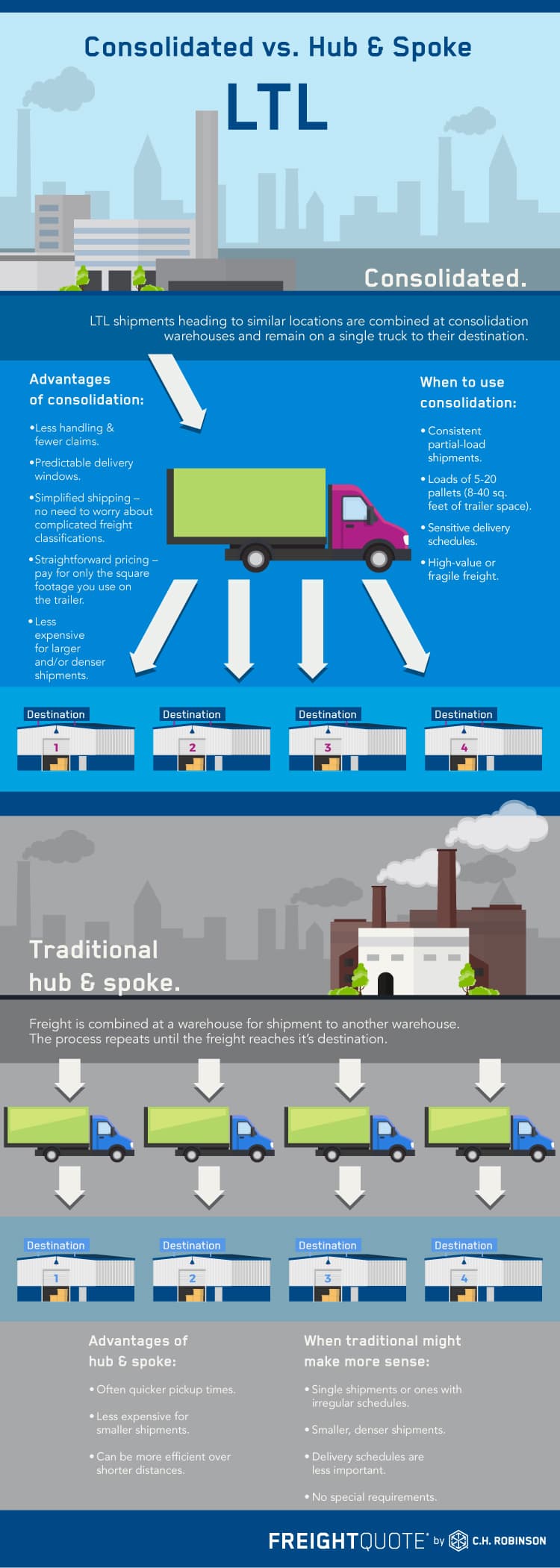Consolidated vs. hub and spoke LTL.
August 25, 2019

As a small or medium sized business, you have a couple choices when it comes to LTL. When determining your preferred LTL shipping method, there are two options that must be considered: LTL consolidation and traditional hub and spoke LTL.
Let's take a look at which option might work best for you and why. Here is your full breakdown of consolidation versus hub and spoke LTL.
Consolidated shipping.
For some, LTL consolidation is a top choice since it can simplify the shipping process. During the process of consolidation, LTL shipments heading to similar locations are combined at consolidation warehouses and remain on a single truck until they reach their final destination.
Advantages of consolidation.
Some of the advantages of consolidated LTL include:
- Less handling and fewer claims.
- Simplified shipping – no need to worry about complicated freight classifications.
- Straightforward pricing – pay for only the square footage you use on the trailer.
- Less expensive for larger and/or denser shipments.
When to use consolidation.
While LTL consolidation is a great option, SMBs should understand which circumstances are a good fit for it and which are not. Here are a few examples of when to use consolidated LTL:
- Consistent partial load shipments.
- Loads of 5-20 pallets (8-40 sq. feet of trailer space).
- Sensitive delivery schedules.
- High-value of fragile freight.
Traditional hub and spoke shipping.
For traditional hub and spoke LTL, things are run a bit differently. During this process, freight is combined at a warehouse for shipment to another warehouse. The process repeats until the freight reaches its final destination.
Advantages of hub and spoke.
Some of the advantages of hub and spoke LTL include:
- Often quicker pickup times.
- Less expensive for smaller shipments.
- Can be more efficient over shorter distances.
When traditional might make more sense.
As stated above, sometimes hub and spoke makes more sense than consolidated LTL. It’s all about understanding which situation calls for what. Let’s look at a few scenarios in which hub and spoke LTL is the better choice:
- Single shipments or ones with irregular schedules.
- Smaller denser shipments.
- Delivery schedules are less important.
- No special requirements.
Final thoughts.
Whether you’re using consolidated shipping or traditional hub and spoke, LTL shipping lets you effectively weigh all your options. The more options you have, the better your chance of finding a carrier that meets your requirements. Shifting through these options to secure the best choice to address timing, budget, and safety needs can be a hassle, which is why you should always ensure you have the right tools on hand to work through your process.
Check out our consolidated vs. hub and spoke LTL shipping infographic below for a detailed look at the importance each shipping option can have on your supply chain logistics. If you’re interested in learning more about how Freightquote can support your freight shipping strategy, start a quote today.

Share this image on your site.
Do you have a shipment to book?
Image credit: iStock
Topics:
Get Your Shipping Quote



